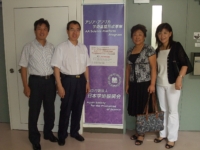Summary: With the coordinated efforts cross multi disciplines such as
engineering, computer science and mathematics/statistics, it is now
absolutely feasible to non-invasively investigate human brain
functions and disease processes using neuroimaging techniques such as
positron emission tomography (PET) and structural/functional magnetic
resonance imaging (MRI) and others.
Using well-established univariate general linear model (GLM) or
multivariate techniques such as independent component analysis (ICA),
Bayesian network, structural equation modeling (SEM) or scaled
subprofile modeling (SSM), we investigated the brain region
[connectivity] changes associated with diseases or cognition tasks.
This talk will give an overview of some these analytic techniques and
findings in our studies of human brain functions (language, memory,
math skill) and diseases such as Alzheimerfs disease (AD).
This talk will also describe several techniques developed in our group
together with their application for detecting abnormalities even
before the onset of the disease in healthy subjects. They include 1)
an adaptation of the Generalized Linear Least Square (GLLS) originally
introduced by Prof. Dagan Feng for the PET quantification of the
fibrillary amyloid deposition, using a relative new tracer, PIB, for
the imaging of plaques in the brain of patients with AD, 2) a
non-invasive approach for the quantification of the cerebral metabolic
rate for glucose (CMRgl) for FDG-PET studies using ICA; 3) an
iterative PCA technique to measure whole brain atrophy from serial MRI
data; 4) and the use of the resampling technique, Bootstrap, to assess
the reliability for search region used in multiple-comparison
corrections and to construct a global index which is free of multiple
comparisons for clinical trial, and finally, 5) the multi-modal
partial least square approach to link multiple data sources together
to increase statistical power.
|

